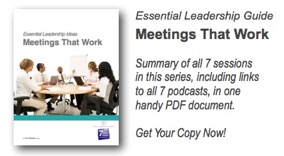Foster Meaningful Dialogue
17/11/09 Filed in: Leadership Articles | 7IC Meetings
To make the most of the talent and knowledge your people have to offer requires meaningful dialogue.
Why? Explicit knowledge can be shared in directives, reports and presentations, but tacit knowledge is brought out by rich dialogue, discussion, and interaction - and tacit knowledge is what gives organizations a competitive edge.
This is especially noticeable in meetings. In our knowledge-based economy, a meeting should be a time when work gets done, not an event that keeps people from their “real” work. In many organizations, meetings seem to be little more than people giving reports. These kind of meetings tend to focus on retrospective information (e.g. last month’s financial report or summaries of projects that people are doing outside of the meeting) - a formula for unproductive and boring meetings. Retrospective information can be useful, but in the most productive and valuable meetings the participants actively focus on aligning their thinking, attuning their values, and planning for action - tasks requiring tacit as well as explicit knowledge.
The following are eight ways that effective leaders encourage dialogue:
Foster Trust Fostering trust is a leader’s JobOne. No discussion will be meaningful if there is not a basic level of trust around the table. Meeting participants must trust they are safe, i.e. feel they will not be punished for speaking up. They must trust that everyone around the table shares a similar purpose. And they must trust that the discussion will make a difference, i.e. that minds are not so made up and that a conversation will contribute value. Effective leaders work to create a condition of trust before tackling sensitive or difficult topics.
Structure the Process
Do your meetings consist solely of individuals making a report? Are all your group discussions exactly the same? Then you are not tapping into the power of the group. One size does not fit all - structure how you have a meeting to match the results you want. For example, rather than simply “discuss” an issue, use brainstorming to stimulate divergent thinking and generate new ideas. Set up a comparative analysis of options to stimulate convergent thinking and select a solution. Take a quick straw vote or metric survey to get a read on the range of opinion. Break into dyads or small groups to increase energy, ideas, and participation.
Make Conflict Constructive
When there is conflict, is it over values or means? A disagreement over means can be resolved logically based on analysis of which option best addresses the issue. Persistent conflict may be due to differing values. Because values are subjective, attempts at objective analysis will be frustrating. Resolving values conflict requires fostering understanding of different interests, dialogue to find common principles, and creating experiences that build respect and trust.
Ask the Right Kind of Question
Open-ended questions are better at generating discussion than closed (i.e. yes/no) questions. “What impact would the new policy have?” starts a different kind of discussion than “Do you support the new policy?” Likewise, discussions in problem-solving mode are different than those in possibility mode. Problem-solving explores obstacles and focuses on fixing what’s broken. Possibility mode explores available assets and experiences of success, and how to get more of them. Leadership and management teams need to intentionally use both modes.
Use a Parking Lot
Don’t let good ideas get you off topic in a meeting. Have a flip chart, white board, or designated note-taker readily available as a “parking lot” to capture ideas that arise which are valuable but off-topic to the current discussion. That way the discussion can stay on course, but good ideas don’t get lost, and can be addressed at a later time.
Don’t Respond to Every Statement or Question
Often what are intended to be group discussions devolve into dialogues with the supervisor, senior executive, or “expert” leading the meeting. The leader responds to every question or comment from someone in the meeting. The meeting becomes a back and forth with the leader, not a group discussion. Leaders who are sensitive to this dynamic will encourage full group dialogue by letting others in the meeting respond to questions and comments.
Go A Little Crazy
Asking people for their “best” and “most creative” ideas can have the reverse effect and interfere with creative thinking. Why? The question itself pre-supposes that any idea suggested must at least be good. Therefore, ideas that do not meet a conventional and quick analysis of ‘good’ are mentally screened out, both consciously and unconsciously.
A better method is to set up a scenario for generating LOTS of ideas, creative ideas, crazy ideas – for example, ask for the most “stupid” ideas, or imagine how Ben Franklin, Atilla, or Captain Kirk would handle a situation. (See 7 Ways to Generate Creative Ideas on the Think Leadership Blog for additional tips.) Judgment, screening, and analysis are appropriate and necessary, but can be applied later, when it’s time to sort, choose, and apply ideas - not while generating them.
Break Into Small Groups
The larger the group, the more difficult it is to have meaningful and inclusive discussion. Structuring the meeting to include dyads, triads, or small groups is a great way to encourage discussion, as well as increase energy and help everyone feel they were included. Generally it is helpful to have brief report-outs from at least a sample of the small groups.
Leadership is less about telling people what to do, and more about authentically engaging them in shaping the future. Rich discussion, debate, and dialogue are important means for engaging people and tapping into their brainpower and talents.
Why? Explicit knowledge can be shared in directives, reports and presentations, but tacit knowledge is brought out by rich dialogue, discussion, and interaction - and tacit knowledge is what gives organizations a competitive edge.
This is especially noticeable in meetings. In our knowledge-based economy, a meeting should be a time when work gets done, not an event that keeps people from their “real” work. In many organizations, meetings seem to be little more than people giving reports. These kind of meetings tend to focus on retrospective information (e.g. last month’s financial report or summaries of projects that people are doing outside of the meeting) - a formula for unproductive and boring meetings. Retrospective information can be useful, but in the most productive and valuable meetings the participants actively focus on aligning their thinking, attuning their values, and planning for action - tasks requiring tacit as well as explicit knowledge.
The following are eight ways that effective leaders encourage dialogue:
Foster Trust Fostering trust is a leader’s JobOne. No discussion will be meaningful if there is not a basic level of trust around the table. Meeting participants must trust they are safe, i.e. feel they will not be punished for speaking up. They must trust that everyone around the table shares a similar purpose. And they must trust that the discussion will make a difference, i.e. that minds are not so made up and that a conversation will contribute value. Effective leaders work to create a condition of trust before tackling sensitive or difficult topics.
Structure the Process
Do your meetings consist solely of individuals making a report? Are all your group discussions exactly the same? Then you are not tapping into the power of the group. One size does not fit all - structure how you have a meeting to match the results you want. For example, rather than simply “discuss” an issue, use brainstorming to stimulate divergent thinking and generate new ideas. Set up a comparative analysis of options to stimulate convergent thinking and select a solution. Take a quick straw vote or metric survey to get a read on the range of opinion. Break into dyads or small groups to increase energy, ideas, and participation.
Make Conflict Constructive
When there is conflict, is it over values or means? A disagreement over means can be resolved logically based on analysis of which option best addresses the issue. Persistent conflict may be due to differing values. Because values are subjective, attempts at objective analysis will be frustrating. Resolving values conflict requires fostering understanding of different interests, dialogue to find common principles, and creating experiences that build respect and trust.
Ask the Right Kind of Question
Open-ended questions are better at generating discussion than closed (i.e. yes/no) questions. “What impact would the new policy have?” starts a different kind of discussion than “Do you support the new policy?” Likewise, discussions in problem-solving mode are different than those in possibility mode. Problem-solving explores obstacles and focuses on fixing what’s broken. Possibility mode explores available assets and experiences of success, and how to get more of them. Leadership and management teams need to intentionally use both modes.
Use a Parking Lot
Don’t let good ideas get you off topic in a meeting. Have a flip chart, white board, or designated note-taker readily available as a “parking lot” to capture ideas that arise which are valuable but off-topic to the current discussion. That way the discussion can stay on course, but good ideas don’t get lost, and can be addressed at a later time.
Don’t Respond to Every Statement or Question
Often what are intended to be group discussions devolve into dialogues with the supervisor, senior executive, or “expert” leading the meeting. The leader responds to every question or comment from someone in the meeting. The meeting becomes a back and forth with the leader, not a group discussion. Leaders who are sensitive to this dynamic will encourage full group dialogue by letting others in the meeting respond to questions and comments.
Go A Little Crazy
Asking people for their “best” and “most creative” ideas can have the reverse effect and interfere with creative thinking. Why? The question itself pre-supposes that any idea suggested must at least be good. Therefore, ideas that do not meet a conventional and quick analysis of ‘good’ are mentally screened out, both consciously and unconsciously.
A better method is to set up a scenario for generating LOTS of ideas, creative ideas, crazy ideas – for example, ask for the most “stupid” ideas, or imagine how Ben Franklin, Atilla, or Captain Kirk would handle a situation. (See 7 Ways to Generate Creative Ideas on the Think Leadership Blog for additional tips.) Judgment, screening, and analysis are appropriate and necessary, but can be applied later, when it’s time to sort, choose, and apply ideas - not while generating them.
Break Into Small Groups
The larger the group, the more difficult it is to have meaningful and inclusive discussion. Structuring the meeting to include dyads, triads, or small groups is a great way to encourage discussion, as well as increase energy and help everyone feel they were included. Generally it is helpful to have brief report-outs from at least a sample of the small groups.
Leadership is less about telling people what to do, and more about authentically engaging them in shaping the future. Rich discussion, debate, and dialogue are important means for engaging people and tapping into their brainpower and talents.
***
by Tom Stevens (c)2009
Tom Stevens helps leaders create and sustain exceptional organizations. To contact him, visit www.ThinkLeadershipIdeas.com or call 800 727-9788
This article may be freely reprinted in your company, association, or commercial publication (or website) under the following terms: that the author attribution, copyright notice, contact information, and this reprint notice be included; and that you inform us that you are using the article (samples appreciated).
If you liked this article, you'll love this resource guide...
blog comments powered by Disqus
